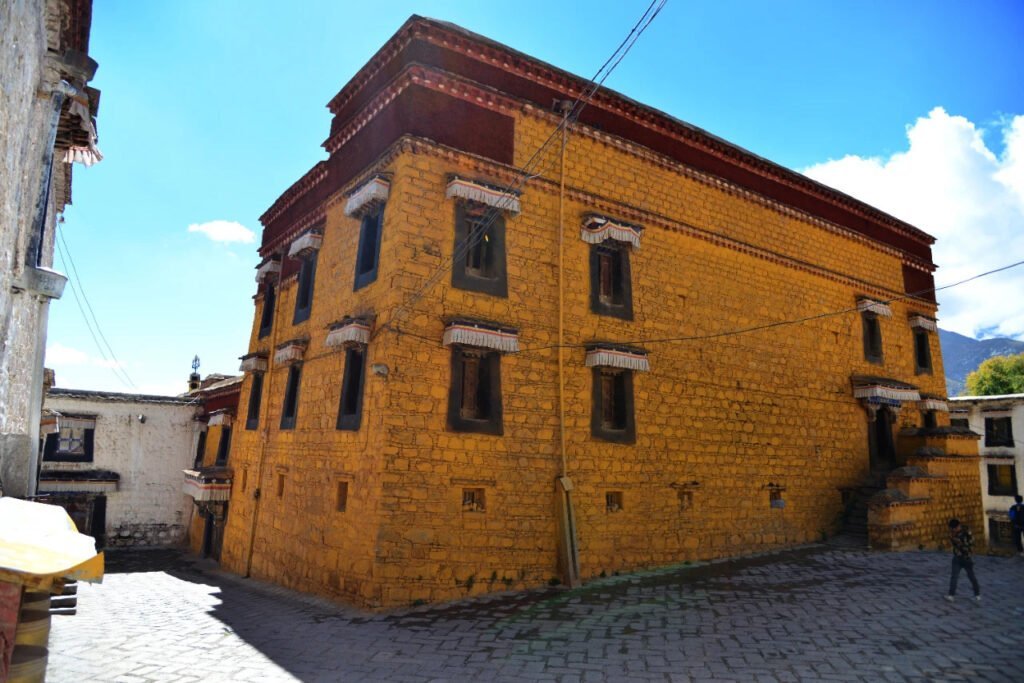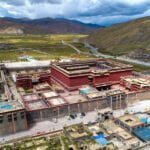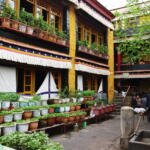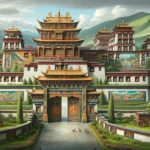Trophug Monastery, also known as Khrophug Monastery or Trophug Jangchub Chöde Monastery, stands proudly on the eastern slope of Trophug Mountain, facing the majestic Ganden Mountain in Tibet’s Sakya County. Nestled in a picturesque valley along the east bank of the Shadu River, this sacred site boasts an elevation of 4050 meters, offering a serene and spiritual retreat.

Origin and Founding of Trophug Monastery
Founded in the year 1212 by the adept translator Trophug Lotsawa Juchen Gyatso, the monastery is the ancestral seat of the Trophug Kagyu tradition. Covering an area of 4800 square meters, Drupa Kagyu, led by disciples Phakmo Drupa Dorje Gyalpo, Trophug Rinboche, and brothers Gyaltsa and Kundan, thrived with over a thousand monks during its zenith.
Architectural Marvels
The monastery’s architectural ensemble includes the grand hall, the Buddha Hall, and the Guardian Deities Hall. The grand hall, facing east, consists of a front porch, scripture hall, and Buddha hall. The scripture hall, spanning two stories with 88 pillars and 99 chambers, features a central skylight supported by four main pillars. The Buddha hall, with an area of 16 pillars, incorporates eight pillars extending to the roof for ventilation and natural light. Additional structures include the abdomen-viewing hall and the face-viewing hall.
The Magnificent Buddha Image
At the heart of the grand hall, a monumental alloy statue of Shakyamuni Buddha, sculpted by the accomplished artist Panchen Shakya shri, stands at an impressive height of approximately 30 meters. The statue, characterized by exquisite craftsmanship and proportion, emanates a grandeur and nobility that captivates the beholder. Flanking the main Buddha image are alloy statues of Shakyamuni Buddha’s eight great disciples, each standing around 1.8 meters tall. The walls are adorned with towering scripture shelves housing precious sets of scriptures such as “Kangyur,” “Tengyur,” and the “Heart Sutra,” written in gold and silver ink.
Trophug Monastery: A Spiritual Haven in Tibet
Trophug Monastery, also known as Khrophug Monastery or Trophug Jangchub Chöde Monastery, graces the eastern slope of Trophug Mountain in Tibet’s Sakya County. Founded in 1212 by the adept translator Trophug Lotsawa Chuchen Gyatso, it serves as the ancestral seat of the Trophug Kagyu tradition. Nestled at an elevation of 4050 meters, the monastery unfolds a tranquil retreat, showcasing exquisite architecture, sacred halls, and captivating artistry.
Architectural Marvels of Trophug Monastery
Grand Hall
- Location: First floor, north side
- Features: Dedicated to the protector deity Gonkhang
- Four pillars: Enshrines a 1.5-meter clay statue of the Four-Armed Avalokiteśvara
- Adorned with weapons, animal skins, and divine symbols
Main Hall (Shakyamuni Hall)
- Location: Western side of the grand hall
- Structure: Two floors
- Area: 4 pillars
- Contents: Alloy statues of Shakyamuni Buddha and Taras
- Over 200 smaller alloy and gold-plated bronze Buddha statues
- Second floor houses the Guardian Deities Hall, featuring a 1.4-meter clay statue of the main protector deity, Sengay Bangwa
Guardian Deities Hall (Gonkhang)
- Location: Eastern side of the grand hall
- Structure:
- Single floor, four pillars
- Main Statue: Clay statue of Palden Lhamo, the protector deity
- Murals and Paintings Highlights:
- Six Realms and Four Longevity paintings in the front hall
- Engaging depictions of Vajrapani, Sixteen Arhats, Milarepa, and more
- Exquisite paintings in the protector deity hall and main hall
Trophug Stupa
Located 450 meters south of Trophug Monastery, the Trophug Stupa stands as one of Tibet’s early monumental stupas. Also known as the “Kubum Thongdrol Chenpo Stupa” or the “Stupa of One Hundred Thousand Buddhas,” this architectural marvel was built by Trophug Lotsawa Chuchen Gyatso in the early 13th century. Though now in ruins, it remains a significant pilgrimage site.
Conclusion
Trophug Monastery, with its diverse halls, sacred statues, and captivating artwork, invites visitors to explore the rich tapestry of Tibetan Buddhism. The blend of architectural splendor, cultural heritage, and spiritual significance makes it a must-visit destination, allowing one to immerse in the profound teachings and serene ambiance of this spiritual haven.
Trophug Monastery, with its rich history, cultural significance, and architectural splendor, serves as a testament to the enduring spiritual legacy of Tibet. The tranquility of its surroundings and the magnificence of its structures make it a captivating destination for both pilgrims and visitors alike.


















